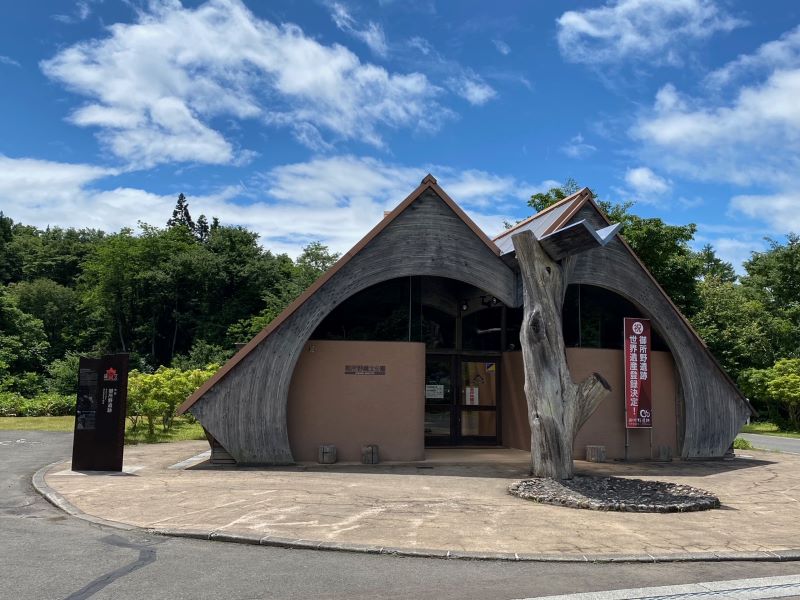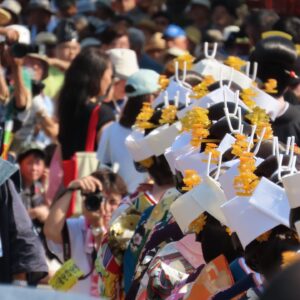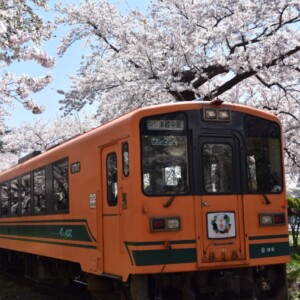
"Place names with doors" from 1 to 9 [Ichinohe and 2 nohe] The origin of the Ichinohe was a town of Jomon ruins, and why is there a Kunohe Castle ruins in Ninohe?
table of contents
The vast area stretching from northern Iwate Prefecture to eastern Aomori Prefecture was called Nukanobu were place names containing the character "to"
Its history is said to have begun with the Oshu Fujiwara clan, or even earlier, but place names with "to" in them remain in the names of cities, towns, and villages to this day
In the coming articles, we will be introducing stories about their origins, the history of "To," and the current state of each "To" town
First, we will introduce Ichinohe Town in Iwate Prefecture and the neighboring city of Ninohe in Iwate Prefecture
"Ichinohe" is the entrance to the vast Nukabe district

From Morioka, drive north on National Route 4 once you cross Jusanbongi Pass
If you take the Tohoku Expressway, it takes about an hour from Morioka IC to Ichinohe IC, and if you take the train, you can the IGR Iwate Galaxy Railway and arrive at Ichinohe Station in about an hour.

In addition to the Jomon ruins, which are a World Heritage Site, the town Bandaikan , and retains the atmosphere of a bygone era.

In addition, milestones from the old Oshu Highway remain intact within the town, and part of the ruins of Ichinohe Castle, the residence of the Ichinohe Nanbu clan, has been preserved as a park along the Route 4 bypass
Goshono Ruins, a World Heritage Site

was registered as a World Heritage Site in July 2021 as one of the " Jomon Ruins in Hokkaido and Northern Tohoku

The ruins, located on a wide plateau, have been opened to the public as a historical park, and pit dwellings have been recreated as a settlement that can be entered. Free guided tours are available without a reservation from the end of April to the end of October

The park is surrounded by nature and you can enjoy it like a picnic, and there is also a museum, so it is a historic park where you can spend a relaxing day with the family

There is also a museum shop inside the museum where you can purchase souvenirs such as Jomon culture related goods, sweets and crafts from Ichinohe Town
Goshono Ruins <Information>
- Name: Goshono Ruins
- Location: Iwadate, Ichinohe-machi, Ninohe-gun, Iwate Prefecture
- Phone: 0195-32-2652
- Opening hours: Tuesday to Sunday 9:00-17:00 (entry to the museum exhibition room is until 16:30)
- Closed: Mondays (or the following day if it is a public holiday), New Year's holidays
- URL: Goshono Ruins Official Website
GOOGLE MAP
There are many famous places and historical sites between Ichinohe and Ninohe

The Mabechi River basin, which connects the two towns , is called Basenkyo is dotted with famous sites such as rocks known as Otokogamiiwa Megamiiwa Myojin-ga-fuchi

The Ookata Cliff , an exposed monolith of sandstone , can be seen from the windows of the national highway and IGR trains, as well as from hills and observation decks in Ninohe City.

valuable historical sites include Namiuchi Pass Cross Layers a natural monument where you can observe striped geological layers
Ninohe, a strategic location surrounded by mountains on all sides

Ninohe City is a major city in northern Iwate Prefecture with a population of approximately 23,000.It is a mountainous city whose urban area developed along the Mabechi River and Appi River basins
IGR Ninohe Station is adjacent to Ninohe Station on the Tohoku Shinkansen, and Morioka City in Iwate Prefecture and Hachinohe City in Aomori Prefecture are connected by the Hachinohe Expressway, which branches off from the Tohoku Expressway
Additionally, the city is located in a W-shape similar to the constellation Cassiopeia with the neighboring Joboji , Ichinohe , Kunohe , and Karumai , with Ninohe at the center, making it a key transportation hub for these towns.
founded Cassiopeia Federation in 1991
Kunohe Castle and Kunohe Masazane

Ninohe is home to Fukuoka Castle, which was once the castle of the Sannohe Nanbu clan, but before that it was called Kunohe Castle because it was the castle of the Kunohe clan
The Kunohe clan is said to have been founded by Yukitsura Mitsuyuki (Nambu Mitsuyuki), , but there are also theories that the Ogasawara clan and the Nikaido clan are its ancestors, making it a clan shrouded in mystery.

At the end of the Sengoku period, Kunohe Masazane, dissatisfied with the main branch of the Nanbu clan, raised an army and started the Kunohe Rebellion, However, the rebellion was put down, and Kunohe Castle was renamed Fukuoka Castle by Nanbu Nobunao.
However, the people of the domain who admired the Kunohe clan continued to call it Kunohe Castle, and in recent years, as Kunohe Masazane has become known as "the man who challenged Hideyoshi," Ninohe City has also officially introduced it as Kunohe Castle Ruins
Kunohe Castle Ruins<Information>
- Facility name: Kunohe Castle Ruins
- Location: Fukuoka Castle, Ninohe City, Iwate Prefecture
- URL: The top of Iwate "Japan's Hometown Ninohe" official website
GOOGLE MAP
What is "Nanyato" in Ninohe?

Cassiopeia Messe Nanyato, located at the west exit of Ninohe Station Nanyatoyara which is a form of entertainment that is passed down in the area .

At the product center, you can purchase local specialties and souvenirs from 19 cities and towns across the three northern Tohoku prefectures, there is a restaurant where you can sample local cuisine, and from the observation tower you can enjoy views of Ninohe city and the Okuzure Cliffs .
What is it? <Information>
- Facility name: Ninohe Regional Tourism and Products Center "Cassiopeia Messe Nanyato"
- Address: 68 Ishikirisho Moriai, Ninohe City, Iwate Prefecture
- Phone number: 0195-23-7210 (Products Center: 0195-22-4395)
- Business hours: 9:00-22:00
- Regular holidays: Open all year round
- URL: Ninohe Regional Tourism and Products Center "Cassiopeia Messe Nanyato" official website
GOOGLE MAP
Kindaichi Onsen and Zashiki Warashi

Kindaichi Onsen is known for its effectiveness in treating neuralgia and skin diseases, and there are nine hot spring inns on the banks of the Mabechi River
At Ryokufuso, located at the very back of the hot spring town, Zashiki Warashi " spirit is said to appear and bring good fortune to those who see it.

The facility was completely destroyed by fire in 2009, but Kamemaro Shrine (Kamemaro is the name of a zashiki-warashi spirit) located on the grounds was the only one that survived, and this became a hot topic among locals, with people saying that "the zashiki-warashi spirit fled into the shrine and so it didn't burn down."
Ryokufuso was rebuilt in 2016, but it is now a popular inn that is difficult to book
Kindaichi Onsen Ryokufuso <Information>
- Facility name: Ryokufuso
- Address: 41, Kindaichichogawa, Ninohe City, Iwate Prefecture
- Phone number: 0195-27-2131
- URL: Ryokufuso official website
GOOGLE MAP
Is it true that the ruins of Kindaichi Castle are the ruins of Yonenohe Castle?

The ruins of Kindaichi Castle , Shinohe Castle, in the city center away from the hot spring resort
this place is " Yonhe ," the more popular theory is that it came to be called Yonohe Castle when the Yonohe clan moved from their original location in Kindaichi, which is the same story as with Kunohe Castle.
Kindaichi Castle Ruins <Information>
- Name: Kindaichi Castle Ruins (Yonenohe Castle Ruins)
- Address: 73 Kindaichidate, Ninohe City, Iwate Prefecture
GOOGLE MAP
summary
There are almost no remains of horse breeding areas in either Ichinohe or Ninohe, and given their topography, it is highly likely that they were strongholds to protect against attacks by the Emishi
there is a place called Koma Yakiba in Kindaichi, Ninohe City
If you head north from Ninohe City on the Oshu Kaido (National Route 4), you will come to the border with Aomori Prefecture just to the north, and beyond that is Sannohe, said to be the birthplace of the Nanbu Soke family









!["Place names with doors" from 1 to 9 [Hachinohe and Kunohe edition] Mystery with different patterns only for the eight and nine positions Hachinohe Catch](https://jp.neft.asia/wp-content/uploads/2024/07/8737ae4878723e4fc7d713b6aed41d96-150x150.jpg)

!["Place names with 'To' in them" from 1 to 9 [Shichinohe Edition] The northernmost To, where the image of a horse breeding area remains strong Shichinohe Catch](https://jp.neft.asia/wp-content/uploads/2024/07/286d15017199ce278766930f20fcf2e8-150x150.jpg)
!["Place names with 'to' in them" from 1 to 9 [Yonohe Edition] Where was the legendary Yonohe? Explore the mysterious Yonohe! Yonohe Catch](https://jp.neft.asia/wp-content/uploads/2024/07/b5ef6cf53fbfad9ad5956ac294a72ed4-150x150.jpg)
!["Place names with doors" from 1 to 9 [Sannohe] Sannohe, the birthplace of the Nanbu clan, is associated with famous places, historical sites and cat towns Sannohe Catch](https://jp.neft.asia/wp-content/uploads/2024/07/68def385b00c53bbd560d023270a45ba-150x150.jpg)
!["Place names with doors" from 1 to 9 [Five and Six Doors Edition] Two simple yet delicious doors Gonohe Catch](https://jp.neft.asia/wp-content/uploads/2024/07/4b7be42f1b789d8475c0e7b0b5c9ab58-150x150.jpg)

![Hachiman Horse - A lucky local toy that is one of Japan's three major pieces and is passed down in the southern horse production area [Hachinohe City, Aomori Prefecture] Hachimanma IC](https://jp.neft.asia/wp-content/uploads/2025/03/IMG_1700-150x150.jpg)











